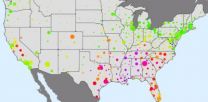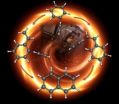(Press-News.org) A discovery by Australian immunologists, uncovering an additional role for antibody-making 'B cells', is considered important enough by the American Association of Immunologists to rank it among the top 10% of articles in the latest issue of The Journal of Immunology, off the press today.
The finding by Senior Research Assistant Stacey Walters and Associate Professor Shane Grey, from Sydney's Garvan Institute of Medical Research, shows that B cells also participate in the development of 'regulatory T cells'.
T cells develop in the thymus gland, a soft triangular organ in the chest cavity. From a 'naïve', or undifferentiated, state they are gradually 'educated' to become helpers, or warriors, or regulators.
Until now, the only non-thymic cells known to educate the regulators were dendritic cells, which travel to the thymus to deliver 'antigen', samples of substances toxic to the body. We now know that B cells can do the same thing.
B cells have been thought to specialize only in the production of antibodies. As newfound educators of T cells as well, B cells become much more interesting and complex characters, potentially useful in helping to prevent organ rejection, or control inflammatory bowel disease, or quell autoimmune conditions.
That is because regulatory T cells control how killer T cells behave – and can effectively prevent the warriors from attacking 'self' tissue, or tissue perceived as foreign. In the case of organ transplantation, several studies have shown that high levels of regulatory T cells can prevent organ rejection.
"Regulatory T cells are critical in the outcome of an immune response – so anything that in turn regulates them becomes very interesting to immunologists," said Associate Professor Grey.
"Right now there are clinical trials around the world looking to expand populations of these cells in patients. Researchers are also working on ways to grow regulatory cells in the laboratory – to infuse into patients as therapy."
"Everyone is interested in finding ways to treat autoimmunity and prevent transplant rejection. Expansion of regulatory T cells should help in both cases."
"Our finding suggests it should be possible to set up systems that harness B cells to expand regulatory cells."
The Garvan lab members worked with mice genetically modified to express high levels of 'BAFF', a substance that increases survival of B cells. The higher number of B cells overall allowed researchers to track the activity of B cells in the thymus.
"It has been known for years that some B cells travel to the thymus, but no-one has understood why," said Stacey Walters.
"Our experiments showed clearly that B cells participated in the creation of regulatory T cells – the more B cells that were in the thymus, the higher the number of regulatory cells generated. That direct correlation raises interesting possibilities."
"One possibility is using BAFF, a non-toxic substance, to ramp up the B cell count of patients before transplant procedures. It will be very interesting to test whether or not that would prevent rejection."
INFORMATION:
Unsuspected aspect of immune regulation revealed
2014-07-01
ELSE PRESS RELEASES FROM THIS DATE:
New analysis of 'swine flu' pandemic conflicts with accepted views on how diseases spread
2014-07-01
The most detailed analysis to date of the spread of the H1N1 2009 pandemic influenza virus, known informally as 'swine flu', has found that short-range travel was likely the primary driver for the 2009 pandemic in the United States, in contrast with popularly accepted views on the way diseases spread.
The study, based on data gathered from health insurance claims made throughout 2009, found that international air travel, which was previously thought to be important in the pandemic, played only a minor role in its spread within the US.
A team of researchers from University ...
Cancer risk: Aspirin and smoking affect aging of genes
2014-07-01
The risk of developing cancer increases with age. Factors like smoking and regular aspirin use also affect the risk of cancer – although in the opposite sense. Researchers from the University of Basel were now able to show that aspirin use and smoking both influence aging processes of the female genome that are connected to colorectal cancer. The Journal of the National Cancer Institute has published their results.
Already in the 1990s, scientists discovered that regular use of aspirin over long periods of time decreases the cancer risk. Since then, numerous studies have ...
Analysis of the Chinese facial profile: Contours of the side face in the Tu & Zang ethnic minorities
2014-07-01
Li Haijun and fellow researchers at Minzu University of China, in Beijing, conducted a series of geometric morphometric analyses of the contours of the side face and variations in the Tu and Zang (Tibetan) ethnic minorities from Qinghai Province, in northwestern China.
Their study, entitled "Morphometric analysis of the Chinese facial profile: Contours of the side face and variations in the Tu and Zang ethnic minorities", was published (in Chinese) in the Chinese Science Bulletin, 2014, Vol 59(16).
The team of researchers used advanced digital cameras and image processing ...
A Spaniard and a Portuguese discover a new species of beetle in the world's deepest cave
2014-07-01
The unusual habitat of the Krubera cave in the Western Caucasus remains a mystery. Researchers from two Spanish universities have discovered a new species of beetle in the depths of this cave.
Cave beetles are one of the most iconic species found in subterranean habitats. They were historically the first living organisms described by science that are adapted to the conditions of hypogean or subterranean life.
Now, a Portuguese scientist and a Spaniard have discovered a new species of beetle in the deepest cave known to man; a cave 2,140 metres deep. It is the Krubera ...
Scientists uncover the key to adaptation limits of ocean dwellers
2014-07-01
The simpler, the more heat-resistant – scientists uncover the key to adaptation limits of ocean dwellers
Bremerhaven, Germany, 1 July 2014. The simpler a marine organism is structured, the better it is suited for survival during climate change. Scientists of the Alfred Wegener Institute, Helmholtz Centre for Polar and Marine Research discovered this in a new meta-study, which appears today in the research journal Global Change Biology. For the first time biologists studied the relationship between the complexity of life forms and the ultimate limits of their adaptation ...
The biology of addiction risk looks like addiction
2014-07-01
Philadelphia, PA, July 1, 2014 – Research suggests that people at increased risk for developing addiction share many of the same neurobiological signatures of people who have already developed addiction. This similarity is to be expected, as individuals with family members who have struggled with addiction are over-represented in the population of addicted people.
However, a generation of animal research supports the hypothesis that the addiction process changes the brain in ways that converge with the distinctive neurobiology of the heritable risk for addiction. In other ...
In study of individual neuron activity, key brain region responds to subjective perception
2014-07-01
LOS ANGELES (June 30, 2014) – When evaluating another person's emotions – happy, sad, angry, afraid – humans take cues from facial expressions. Neurons in a part of the brain called the amygdala "fire" in response to the visual stimulation as information is processed by the retina, the amygdala and a network of interconnected brain structures. Some of these regions respond just to the actual features of the face, whereas others respond to how things appear to the viewer, but it is unknown where in the brain this difference arises.
Although the amygdala's importance in ...
Up in flames: Evidence confirms combustion theory
2014-07-01
Researchers at the Department of Energy's Lawrence Berkeley National Lab (Berkeley Lab) and the University of Hawaii have uncovered the first step in the process that transforms gas-phase molecules into solid particles like soot and other carbon-based compounds.
The finding could help combustion chemists make more-efficient, less-polluting fuels and help materials scientists fine-tune their carbon nanotubes and graphene sheets for faster, smaller electronics. In addition, the results could have implications for the burgeoning field of astrochemistry, potentially establishing ...
Study finds online bullying creates off-line fear at school
2014-07-01
HUNTSVILLE, TX (7/1/14) -- Cyberbullying creates fear among students about being victimized at school, a recent study by Sam Houston State University found.
While traditional bullying still creates the most fear among students, cyberbullying is a significant factor for fear of victimization at school among students who have experienced bullying or disorder At school, such as the presence of gangs. The fear from cyberbullying is most prominent in minority populations.
"It cannot be overstated – online victimization has offline consequences, and those consequences may ...
Scientists discover how plastic solar panels work
2014-07-01
This news release is available in French.
Scientists don't fully understand how 'plastic' solar panels work, which complicates the improvement of their cost efficiency, thereby blocking the wider use of the technology. However, researchers at the University of Montreal, the Science and Technology Facilities Council, Imperial College London and the University of Cyprus have determined how light beams excite the chemicals in solar panels, enabling them to produce charge. "Our findings are of key importance for a fundamental mechanistic understanding, with molecular ...





